What if I told you that capturing the raw power and grace of nature’s most magnificent predator could transform your artistic journey forever?
Drawing falcons isn’t just about mastering feathers and talons – it’s about channeling the fierce spirit of freedom, precision, and untamed wilderness onto paper.
Whether you’re a parent encouraging kids to explore wildlife art or an adult seeking to challenge your creative boundaries, falcon illustrations offer the perfect blend of technical complexity and emotional intensity that will push your skills to soar.
The Majesty Behind Falcon Art: Why These Birds Captivate Artists
There’s something absolutely electrifying about falcons that makes them irresistible subjects for artistic exploration. These aren’t just birds – they’re living embodiments of speed, power, and razor-sharp focus that have fascinated humans for thousands of years.
When you create falcon art, you’re tapping into ancient symbolism that spans cultures worldwide. From Egyptian hieroglyphs to medieval heraldry, falcons represent nobility, vision, and the bridge between earth and sky.
This rich cultural heritage gives depth to every sketch you create, making each piece more than just a drawing – it becomes a conversation with history itself.
The technical challenges of falcon illustration also make them perfect training subjects for artists wanting to level up their skills. Their streamlined bodies demand understanding of aerodynamics, their piercing eyes require mastery of expression, and their intricate feather patterns push your detail work to new limits.
For kids, falcons become gateways to learning about wildlife and conservation, while adult artists find in them the perfect subject for exploring realism, movement, and emotional intensity.
Falcon Art: Majestic Portraits That Command Respect
The Piercing Gaze Portrait
Nothing captures a falcon’s essence quite like a close-up portrait focusing intensely on those legendary eyes. This art piece centers on the bird’s head and upper chest, with special attention to the mesmerizing stare that has made falcons legendary hunters throughout history.
Start with the eye as your focal point – it should be large, alert, and filled with intelligence that seems to look right through the viewer. The beak needs to show its hooked predatory shape, while the surrounding facial feathers create a natural frame.
Pay special attention to the subtle color variations around the eyes and the way light catches the curved surfaces of the beak.
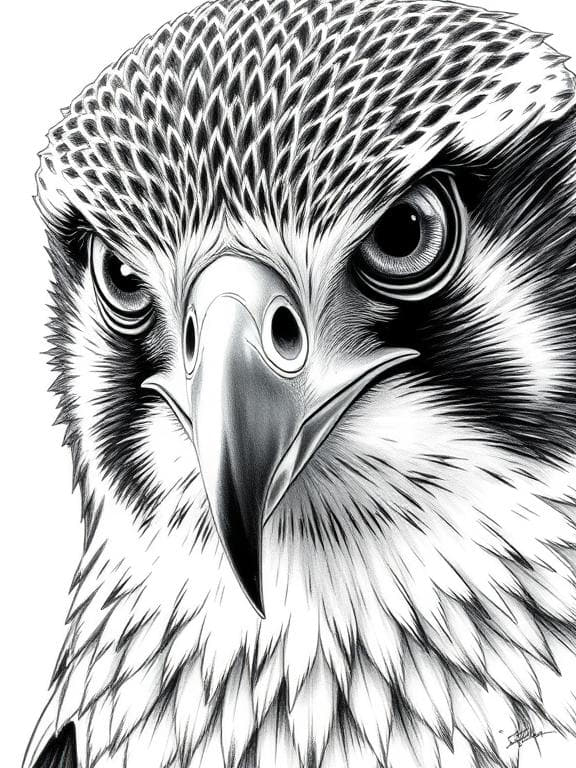
The beauty of this portrait style lies in its emotional impact. Viewers should feel they’re making direct eye contact with a wild creature, experiencing that primal recognition between predator and observer. Use strong contrasts between light and shadow to enhance the dramatic effect.
Royal Falcon on Perch
Create a regal composition showing a falcon perched majestically on a weathered fence post or dead tree branch. This drawing emphasizes the bird’s noble bearing and natural authority, perfect for artists who want to capture dignity and poise.
Focus on the falcon’s posture – chest proud, head held high, talons gripping the perch with casual confidence. The surrounding environment should complement rather than compete with the bird, perhaps featuring a simple background with hints of open landscape or cloudy sky.
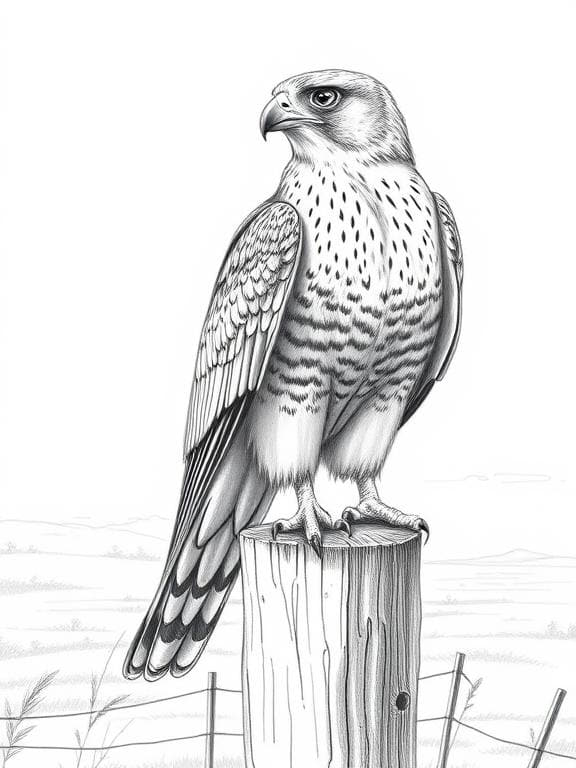
This type of illustration works beautifully for kids because it tells a clear story while teaching them about falcon behavior and habitat. The static pose also makes it more manageable for beginning artists to capture proportions and details without worrying about complex action sequences.
Hunting Stance Falcon
Depict a falcon in the classic hunting position – body low and forward, eyes locked on unseen prey, every muscle coiled for explosive action. This art piece captures the split second before the strike, when all the bird’s energy is focused like a loaded spring.
The pose should convey tension and anticipation. The falcon’s neck extends forward, wings are slightly raised for balance, and talons grip the perch with increased pressure. Even the feathers should seem to bristle with anticipation.
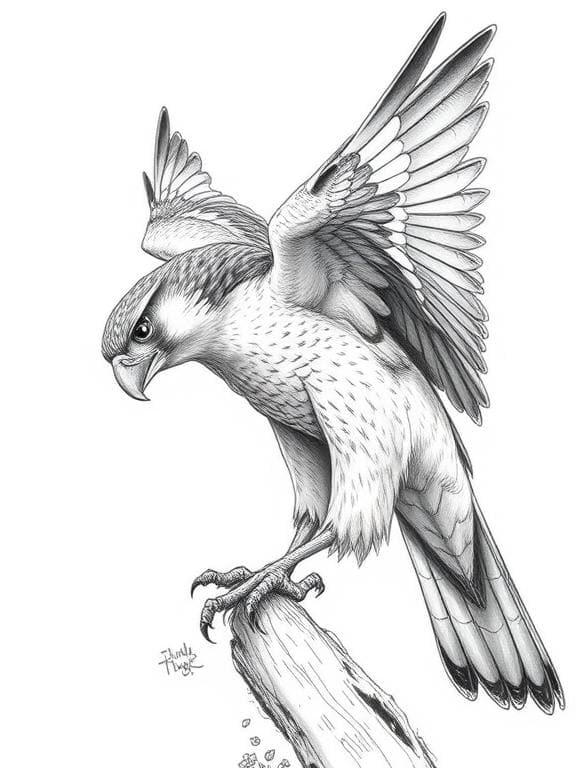
This sketch teaches valuable lessons about animal behavior and the predator-prey relationship, making it educational as well as visually striking. The dramatic pose also provides excellent practice for artists working on dynamic compositions and capturing movement in still images.
Falcon Family Nest Scene
Design a heartwarming scene featuring adult falcons with their young in a clifftop nest. This drawing shifts focus from the fierce hunter image to the nurturing parent, showing falcons’ gentler side that many people never consider.
Include details like the nest construction, the protective positioning of parent birds, and the fluffy appearance of young falcons. The composition should feel secure and peaceful, perhaps with one parent keeping watch while the other tends to the chicks.

This family-oriented art appeals strongly to kids and helps them understand that even powerful predators have caring, protective instincts. It’s also excellent practice for artists working on group compositions and varying ages/stages of the same species.
Falcon in Natural Habitat
Create a comprehensive scene showing a falcon within its natural environment – perhaps perched on a rocky outcrop overlooking a vast valley, or standing alertly in grassland habitat. This illustration tells a complete environmental story.
The background should be detailed enough to establish setting but not so busy that it distracts from the main subject. Include elements like appropriate vegetation, geological features, and weather conditions that falcons actually encounter in the wild.
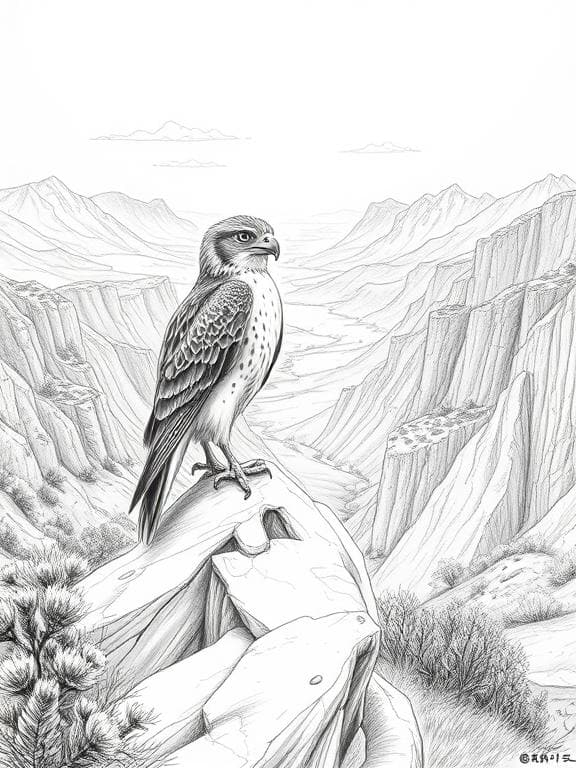
This type of art piece serves as both wildlife illustration and landscape study, giving artists practice with multiple elements while educating viewers about falcon ecology and conservation needs.
Falcon Illustration: Dynamic Scenes That Capture Motion
Falcon in Spectacular Dive
Nothing showcases falcon mastery quite like capturing them in their famous hunting dive – wings pulled tight against their body, reaching speeds that make them the fastest animals on Earth. This illustration demands understanding of aerodynamics and extreme motion.
The key challenge is showing speed while maintaining clarity of form. The falcon’s body should be streamlined like a missile, with feathers pressed flat against the body by wind pressure. Include motion lines, blurred background elements, or other techniques to suggest the incredible velocity.
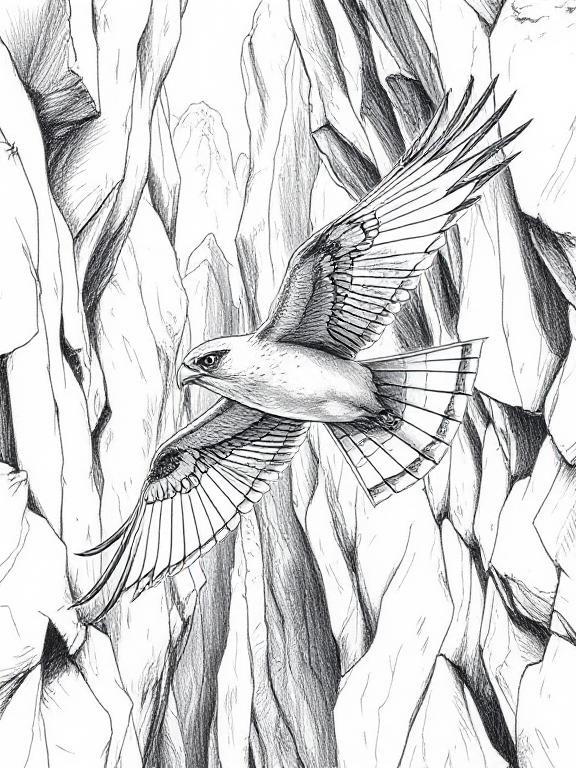
This dynamic drawing excites both kids and adult viewers because it captures one of nature’s most spectacular moments. The technical challenge of rendering high-speed motion also pushes artists to experiment with new techniques for showing movement and energy.
Falcon Swooping Through Canyon
Design an action scene with a falcon navigating through a narrow canyon, wings angled for precise maneuvering as it follows the rocky contours. This art piece combines the bird’s grace with dramatic landscape elements.
The canyon walls should frame the action without overwhelming it, creating a sense of speed and precision flying. The falcon’s wing position and body angle should show active steering and control, demonstrating their incredible aerial agility.
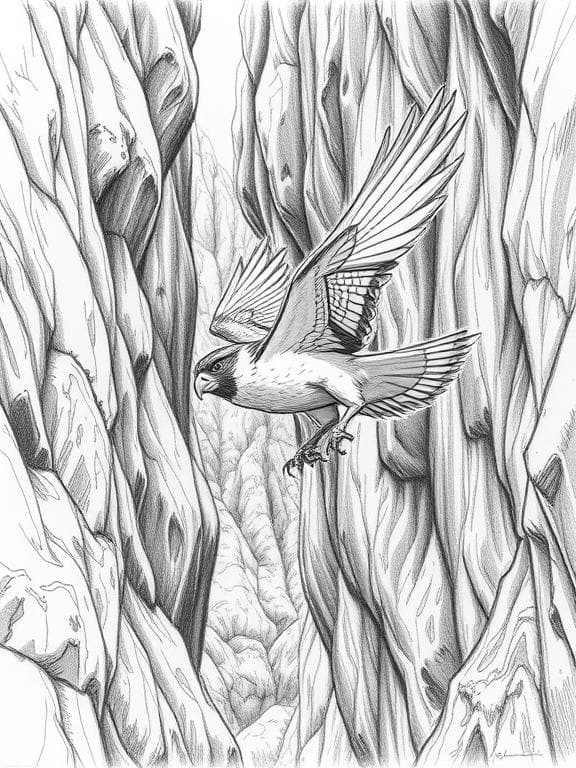
This sketch appeals to adventure-seekers and nature lovers while providing excellent practice with perspective, environmental design, and showing motion within confined spaces. It’s particularly effective for teaching kids about falcon flight capabilities and natural obstacle navigation.
Mid-Flight Wing Detail Study
Focus intensely on the mechanical marvel of falcon wings during flight – every feather positioned precisely for maximum aerodynamic efficiency. This illustration becomes both art piece and scientific study, perfect for detail-oriented artists.
Show individual flight feathers, their overlapping patterns, and how they work together to generate lift and control. Include subtle indications of air flow around the wings and the muscular structure that powers this biological flying machine.
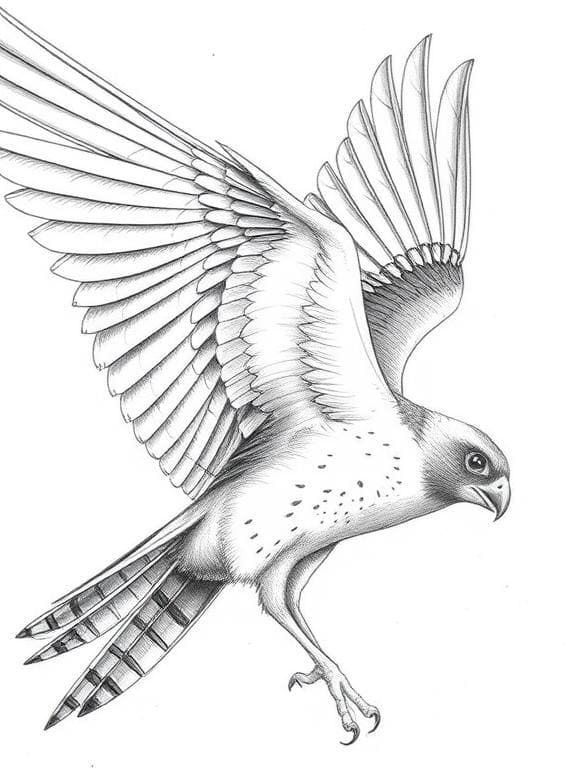
This technical drawing fascinates adult artists interested in the intersection of art and science, while helping kids understand the engineering principles behind flight. It’s invaluable practice for artists wanting to master complex organic structures and realistic detail work.
Falcon and Prey Interaction
Capture the dramatic moment of a successful hunt – perhaps a falcon with captured prey, showing both the triumph of the predator and the reality of nature’s food chain. This art requires sensitivity in depicting natural processes.
The composition should emphasize the falcon’s skill and power while treating the subject matter respectfully. Focus on the bird’s concentration and the successful completion of its natural behavior rather than any graphic details.
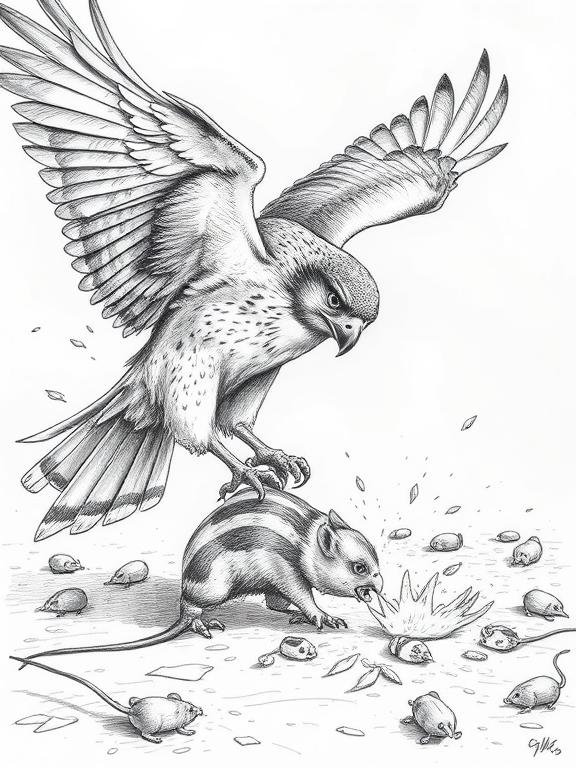
This illustration opens discussions about ecology, food chains, and the role of predators in healthy ecosystems, making it educational for kids while providing adult artists with practice in complex, emotionally charged subject matter.
Falcon Training Session
Depict the ancient art of falconry, showing a trained falcon returning to its handler’s glove. This drawing connects modern viewers with thousands of years of human-falcon partnership and mutual respect.
Include the falconer’s protective glove, the bird’s focused approach, and the moment of trust as wild power meets human partnership. The background might hint at the training environment without overwhelming the central interaction.
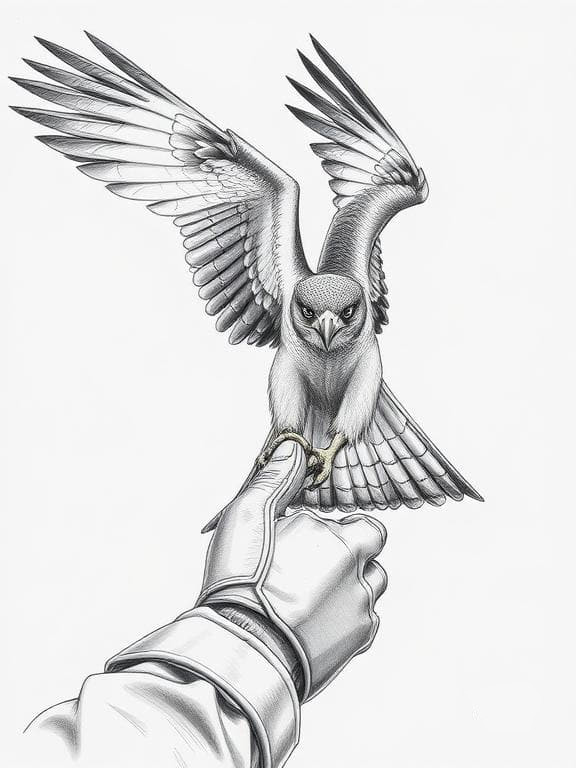
This sketch appeals to history enthusiasts and adds cultural context to falcon art, while teaching kids about the relationship between humans and wildlife throughout history.
Falcon Sketch: Quick Studies That Capture Essence
Rapid Flight Gestures
Develop a series of quick gesture sketches capturing falcons in various flight positions – diving, soaring, banking, and hovering. These loose, energetic drawings focus on capturing movement and attitude rather than precise details.
Each sketch should take no more than a few minutes, emphasizing the essential lines that define the pose and motion. Use confident, flowing strokes that mirror the bird’s grace and power, avoiding overworking any single drawing.
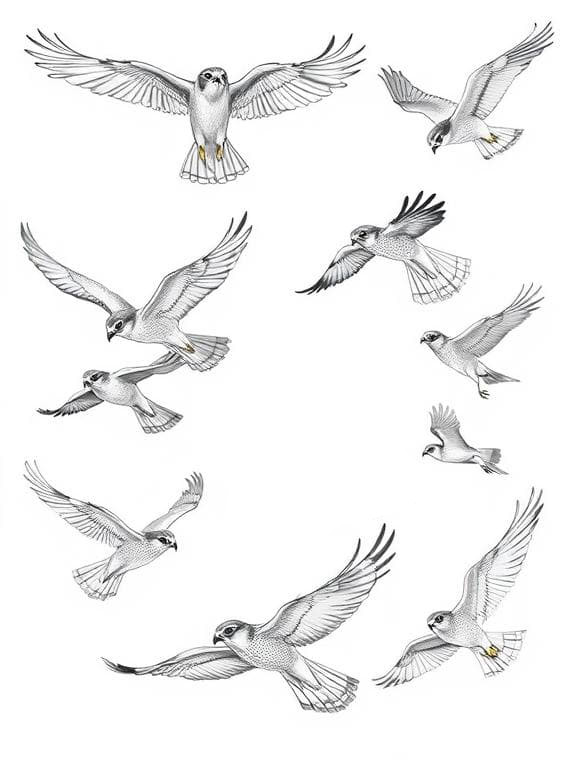
This approach is perfect for kids because it emphasizes fun and expression over technical perfection, while helping adult artists develop their ability to see and capture essential elements quickly. These studies also serve as valuable reference material for more detailed works.
Feather Pattern Studies
Create detailed sketches focusing specifically on falcon feather patterns – the intricate markings that make each species unique. These studies become valuable references for more complex art pieces while building observational skills.
Document different feather types: the smooth flight feathers, the detailed breast patterns, the distinctive head markings, and the powerful tail feathers. Each study should focus on accurate pattern reproduction and texture rendering.
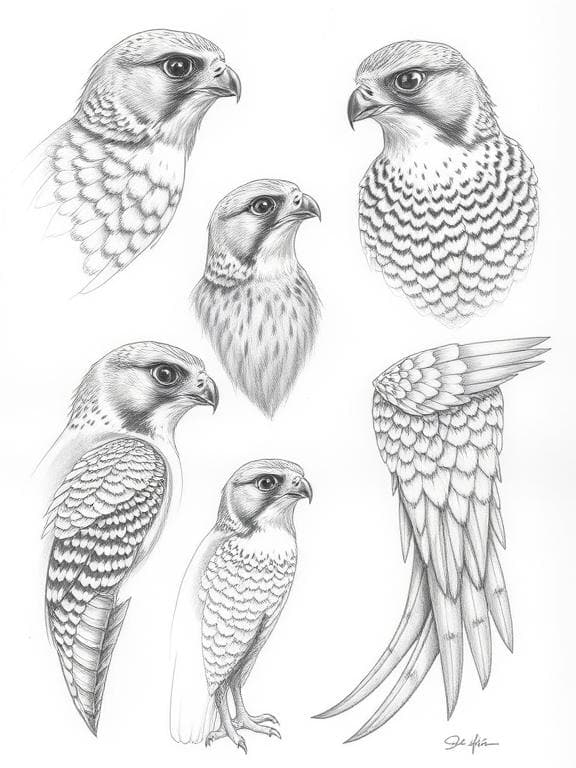
These technical sketches help both kids and adults develop attention to detail and scientific observation skills. They’re also practical references that make future falcon illustrations more accurate and convincing.
Head Study Collection
Develop a series of falcon head studies from different angles – profile, three-quarter view, front-facing, and looking up. These drawings focus on understanding the bird’s structure and expression from multiple perspectives.
Each study should emphasize different aspects: the noble profile, the intense frontal stare, the elegant neck curve, and the powerful beak structure. Pay special attention to how the eyes and beak relationship changes with viewing angle.
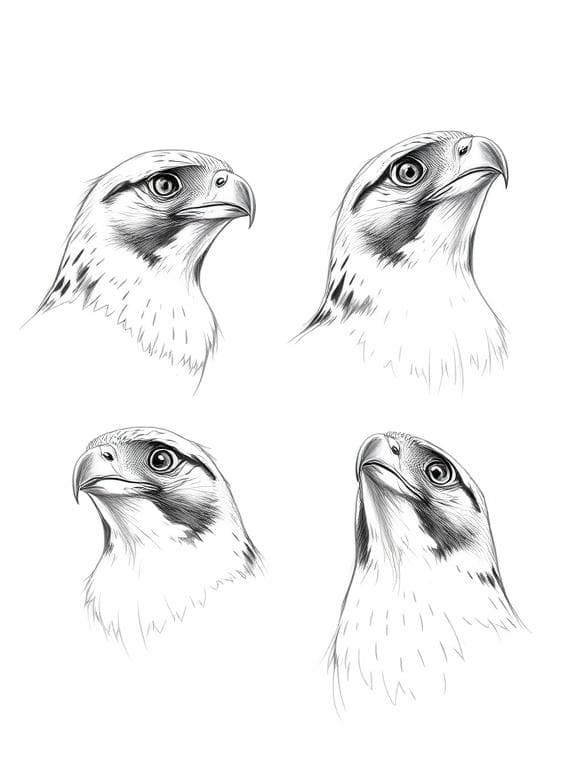
This systematic approach helps artists understand three-dimensional form while providing kids with manageable projects that build confidence and skill progressively.
Talon and Foot Studies
Focus specifically on falcon feet and talons – these incredibly powerful tools that make their hunting success possible. These sketches become both anatomical studies and practice in drawing complex, articulated structures.
Show the talons both relaxed and gripping, demonstrating their incredible strength and precision. Include details of scale texture, the arrangement of toes, and the curved shape that makes them such effective weapons.
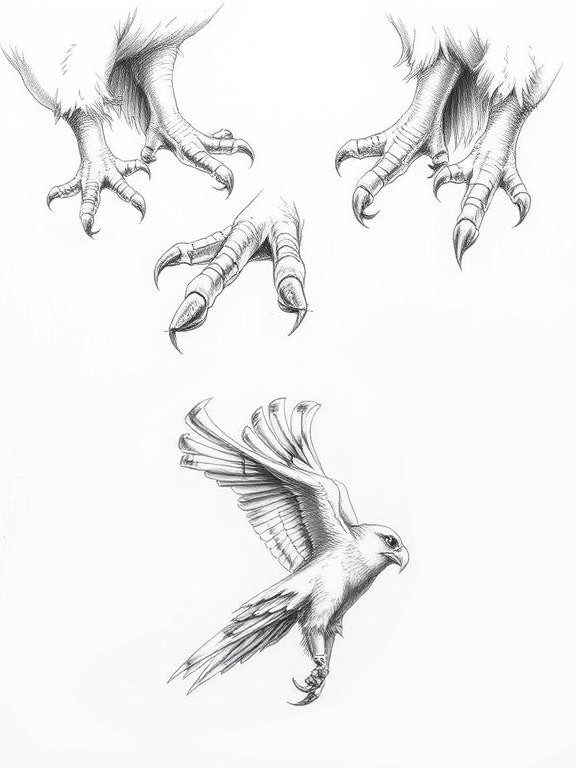
These detailed studies fascinate both kids and adults by revealing the engineering behind nature’s perfect hunting tools, while providing valuable practice in drawing complex organic forms and textures.
Techniques for Bringing Your Falcon Art to Life
Understanding Falcon Anatomy
Successful falcon art starts with understanding the bird’s unique physical structure. Study how their bodies are perfectly designed for speed and hunting – the streamlined torso, powerful chest muscles, and aerodynamic head shape all serve specific functions.
Pay attention to proportions: falcon heads are relatively large compared to songbirds, their necks are thick and powerful, and their wings are pointed rather than rounded. These details make the difference between a generic bird drawing and a convincing falcon illustration.
Build a reference collection of falcon photos from different angles and in various poses. This library becomes invaluable when working on original compositions or when you need to check anatomical accuracy in your sketches.
Your Turn
Whether you’re helping kids discover the joy of wildlife art or pushing your own adult artistic boundaries, falcon drawing offers endless opportunities for growth, discovery, and creative fulfillment.
So grab your pencil, find some falcon references, and let these magnificent birds inspire your creativity to soar to new heights.
